Dolby Atmos may be the single coolest thing to happen to home theater and home audio in the past decade. The only thing better than hearing your movies and music come from all around you is to hear sound emanating from all around and above you. And that's just what Dolby Atmos does. It uses object-oriented encoding to create a truly three dimensional surround sound field with sound coming from virtually everywhere.
NOTE: Check out our updated version of this guide with the newest immersive audio-capable receivers: 2015/2016 Guide to Receivers with Dolby Atmos, DTS:X
But to bring that sound home, you're going to need to upgrade some gear. We've covered the basics of how you can do Dolby Atmos at home in "How to Do Dolby Atmos at Home" but now we'd like to dive into the specifics. Yes, you will need new speakers, but just as importantly, you're going to need a new processor or a new home theater receiver to do the actual Dolby Atmos decoding. Below is a guide to what's currently out there (or coming soon) in the Dolby Atmos-compatible home theater receiver marketplace.
One important thing to consider is how many speakers you'll need. The minimum speaker configuration for Dolby Atmos is 5.1.2: five standard surround speakers plus a subwoofer and two height channels. And while this may be fine for a small room, we'd recommend four height speakers where possible (5.1.4 or 7.1.4 configurations). Some receivers only support up to 5.1.2, and some require additional power amps to do the larger implementations so be sure to check the details before finalizing your receiver choice.
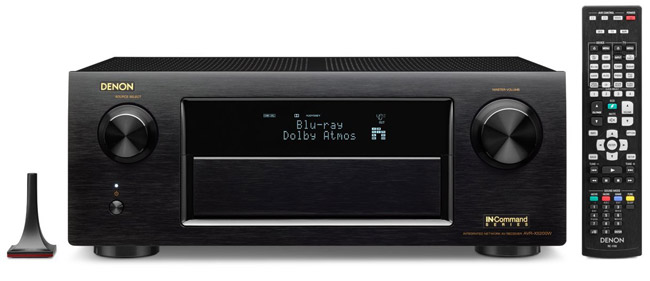
Denon
Denon started shipping both of its Atmos-capable receivers in August. The top of the line is the AVR-X5200W, a 9.2-channel receiver that can accommodate 5.1.4 or 7.1.2 Dolby Atmos set-ups. It can even support a full 11-channel home theater, with a 9.1.2 or 7.1.4 Dolby Atmos configuration by adding a separate stereo power amplifier. As you'd expect from a newer receiver, this one also supports 4K on all eight of the HMDI inputs and three HDMI outputs. Boasting 140 watts per channel, the AVR also has options for a second and third zone, 3D video pass-through, built-in Wi-Fi, Bluetooth, AirPlay and DLNA, as well as Audyssey MultEQ XT32/LFC calibration tools.
The AVR-X4100W is a 7.2-channel receiver that can also do 5.1.2 Dolby Atmos, or 5.1.4 or 7.1.2 configurations with a separate stereo amp. This one also does just about everything you see above, but with 125 watts per channel.
Denon announced that both of these receivers will be eligible for a firmware update in December to support the AURO-3D format. There will most likely be an additional charge for this update.
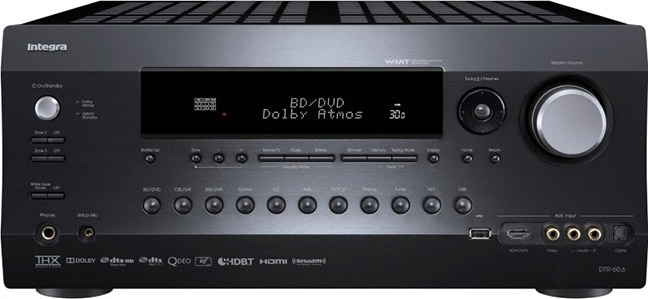
Integra
Integra will be packing Dolby Atmos into a variety of receivers this year. The company will offer Dolby Atmos support for the existing DTR-30.6, the DTR-40.6 and the DTR-50.6 via a firmware upgrade that should be available as you read this (September 29, 2014). All three of those receivers support two height channels (5.1.2 Dolby Atmos configurations). If you're looking for something shiny and new (and with more channels supported), the company will include Dolby Atmos in the DTR-60.6 and DTR-70.6 receivers.
The DTR-60.6 is a THX-certified 9.2-channel AVR, with 135 watts per channel and support for HDMI 2.0 4K/60Hz and HDCP 2.2. In terms of Dolby Atmos configurations, it can do 5.1.2, 5.1.4 and 7.1.2 using the built-in amps. It can also do 7.1.4 and 9.1.2 by adding a stereo power amplifier. It features 3-Stage Inverted Darlington Circuitry and support for Dolby Atmos, Dolby TrueHD, Dolby Digital Plus, DTS-HD Master Audio, Dolby Pro Logic IIz and DTS Neo:X. Other features include AccuEQ room calibration, 3D pass-through, Marvell Qdeo 4K upscaling, eight HDMI inputs and three HDMI outputs plus an HDBaseT port. There's even a phono input for you vinyl fans.
For a slight step up, the DTR-70.6 is an 11.2-channel AVR with Dolby Atmos support, 135 watts per channel, and several of the other features mentioned above. However, it promises to pump up the performance of your home theater via triple high-current transformers, separate processing and amp blocks, and 32-bit D/A conversion. It also has support for up to four zones. With its internal amps (11 of them!), it can do any Dolby Atmos configuration up to 7.1.4 or 9.1.2.
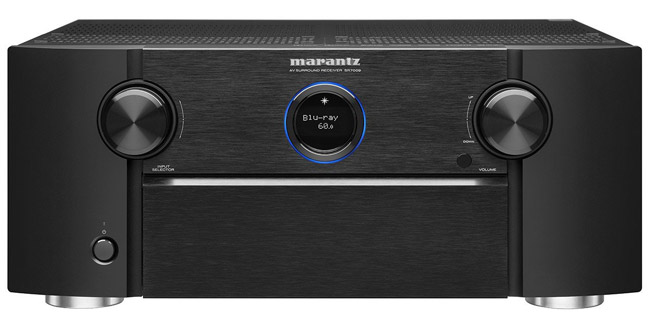
Marantz
The SR7009 is Marantz's very first Atmos-capable receiver. It has nine discrete amplifier channels, each of which boasts 125 watts of power. However, thanks to four DSP (Digital Sound Processing) engines, this AVR can do up to 11.2 channels (with an extra amp) and support Atmos, as well as Audyssey DSX. As far as Dolby Atmos configurations, it can do 5.1.2 or 5.1.4 (5 channels plus 2 or 4 height channels) or 7.1.2 (seven channels plus 2 height channels) using the built-in amplifiers. It can also do a full 7.1.4 or even 9.1.2 configuration using a separate stereo power amp. Other features include built-in Wi-Fi, Bluetooth, 4K and 3D support, three HDMI outputs, a 13.2-channel pre-out capability, and the Audyssey MultEQ XT32 / Sub EQ HT/LFC (Pro ready) room correction suite.
Marantz announced that the SR7009 will be eligible for a firmware update in December to support the AURO-3D format. There will most likely be an additional charge for this update.
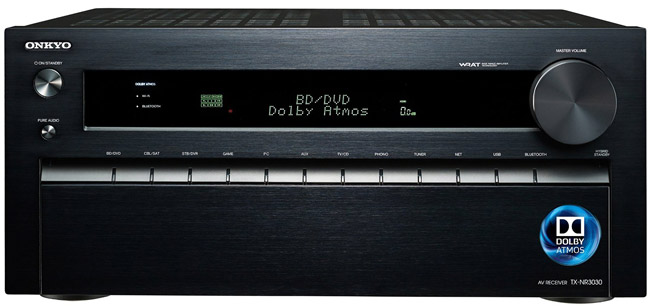
Onkyo
Onkyo is sinking its teeth into this new technology, by sinking Dolby Atmos into a lot of its products. First of all, the company is delivering firmware upgrades for the 7.2-channel TX-NR636, TX-NR737, and TX-NR838 network A/V receivers which are already on the market. With the firmware upgrade, these three all offer two Dolby Atmos-compatible height channels for a 5.1.2 Dolby Atmos configuration.
As far as new offerings, Onkyo has the 9.2-channel TX-NR1030 and the 11.2-channel TX-NR3030. Both AVRs have THX Select2 Plus certification, two 32-bit DSP engines, seven discrete TI Burr-Brown DACs, a dedicated HDMI Zone 2 Out for routing video to a second display, Wi-Fi, Bluetooth, and even a phono input. Both also have eight HDMI inputs and three HDMI outputs, with support for 4K video at 60Hz with HDCP 2.2 for 4K streaming and broadcasts. Other features include DTS Neo:X, AccuEQ room calibration, a 4K/60 Hz HDMI Sub Out and Marvell's Qdeo technology.
For Dolby Atmos configurations, the TX-NR1030 supports 5.1.2, 5.1.4 and 7.1.2 configurations using the on-board amps. It can be bumped up to 7.1.4 or 9.1.2 by adding a separate stereo amp. The TX-NR3030 can handle any Atmos configuration up to 7.1.4 or 9.1.2 using its on-board amps.
The TX-NR3030 is also a nice standout for high res audio playback, thanks to 192 kHz/32-bit processors and 192 kHz/24-bit two-channel DACs.
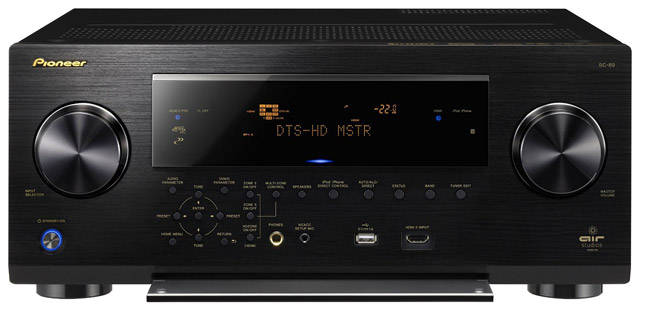
Pioneer Elite
Pioneer is offering three brand-new high-end 9.2-channel AVRs this year in their Elite lineup, all of which support Dolby Atmos via a free firmware upgrade. The SC-85, the SC-87, and SC-89 are similar in design, with the SC-87 offering more robust multi-zone capabilities and the SC-89 offering upgraded digital and analog audio circuitry for the highest sonic performance in the line. The SC-85 is rated at 135 Watts/Channel with all channels driven while the SC-87 and SC-89 are rated at 140 Watts/Channel with all channels driven.
All three of the 9.2-channel AVRs have cool-running Class D3 amplifier technology and a new MCACC Pro calibration system -- the kind that can support Dolby Atmos. Other features include ESS SABRE32 Ultra DACs, HDMI 2.0, multizone network capabilities, and Roku Ready certification so you can plug a Roku Streaming Stick into each receiver's MHL port. Each one can also directly tap into web radio, as well as streaming services like Spotify, Pandora and vTuner. All three even have two-way RS-232 and IP control, making each one a nice addition to one of the home control systems from Crestron, Control4, and more.
The current suite of Pioneer Elite receivers support Dolby Atmos configurations of 5.1.2, 5.1.4, and 7.1.2 channels.
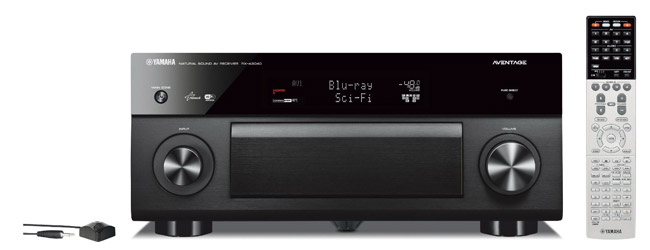
Yamaha
The last in our 2014 lineup is a pair of AVRs from Yamaha. Each one has support for HDMI 2.0, which means both can handle all of the 4K your eyes can handle. They can even upconvert video to 4K 60p. Other features include Yamaha's Virtual CINEMA FRONT technology, support for the Yamaha AV Controller app, AirPlay wireless streaming, and access to Pandora, Spotify Connect, Rhapsody, SiriusXM and vTuner out of the box.
The 9.2-channel RX-A2040 also includes HDMI multi-zone switching and the YPAO - R.S.C. calibration software with multipoint measurement, as well as two ESS ES9006 SABRE Premier Audio DACs. The RX-A2040 supports Dolby Atmos in 5.1.2, 5.1.4 and 7.1.2 configurations.
The 9.2-channel RX-A3040 stands out because of its ability to expand up to 11.2 channels. It also has Yamaha's own CINEMA DSP HD technology, an ESS Technology 192 kHz/32-bit ES9016 DAC for the seven main channels, and an ESS ES9006 SABRE Premier Audio DAC for the others. Other perks include HDMI multi-zone switching and the YPAO - R.S.C. (Reflected Sound Control) with 3D calibration system. The RX-A3040 supports Dolby Atmos in 5.1.2, 5.1.4 and 7.1.2 configurations using its on-board amps, and can be upgraded to 7.1.4 or 9.1.2 by adding a stereo power amp.